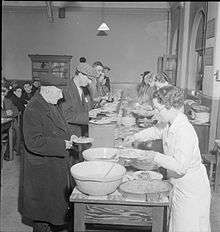British Restaurant

British Restaurants were communal kitchens created in 1940 during the Second World War to help people who had been bombed out of their homes, had run out of ration coupons or otherwise needed help.[1][2] In 1943, 2,160 British Restaurants served 600,000 very inexpensive meals a day.[3] They were disbanded in 1947. There was a political dimension as well, as the Labour Party saw them as a permanent solution to equalising consumption across the class line and guaranteeing a nourishing diet to the poor.[4]
Second World War
Originally called 'Community Feeding Centres', the name British Restaurants was chosen by the Prime Minister, Winston Churchill.[5] They were set up by the Ministry of Food and run by local government or voluntary agencies on a non-profit basis. Meals were sold for a set maximum price of 9d (equivalent to just under 4p, about US$2 US or £1 GBP in purchasing power 2008) or less. No-one could be served with a meal of more than one serving of meat, game, poultry, fish, eggs, or cheese.[6] In one in ten restaurants the meals were prepared at central depots. Schools were often used because they had cafeterias and kitchens. In London mobile canteens delivered meals to air raid shelters and on the street in the aftermath of air raids.[7]
By contrast ordinary private restaurants continued in operation and were not subject to rationing. They did have some restrictions: for instance no meal could be more than three courses and the maximum price was five shillings (equivalent to $10 or £5 in buying power by 2008).
By mid-1941 over two hundred British Restaurants operated in the London County Council area, although the Wartime Social Survey conducted in 1942–43 indicated they were more popular in London than in the rest of the country.[8] In November 1942 there were 1,899 restaurants, in November 1943 there were 2,145 and in December 1944 there were 1,931.[9] 546 authorities made profits and 203 made losses, though they were set up to be not-for-profit.
Some smaller places did not qualify for a British Restaurant but instead had what was termed a "Cash and Carry Restaurant" with meals being delivered from a nearby British Restaurant.[10]
Post-war
After 1947 some restaurants were converted, under the Civic Restaurants Act, into civic restaurants run by the local council. If a civic restaurant operated at a loss for three consecutive years the act provided that ministerial consent would be needed for it to continue to remain open. These restaurants existed at least into the mid-1950s.
See also
References
- ↑ see "Sources for the History of London 1939–45: Rationing" History in Focus: War
- ↑ Atkins (2011) pp 129-54
- ↑ Angus Calder, The People's War: Britain 1939–45 (1969) p 386
- ↑ Atkins (2011) pp 144–45
- ↑ Calder, The People's War: Britain 1939–45 (1969) p 386
- ↑ Food Rationing pages at www.worldwar2exraf.co.uk, archived from the original on 8 June 2008, retrieved 2009-09-05
- ↑ Atkins (2011) p 142
- ↑ "5", Sources for the History of London 1939–45, pp. 85–86, retrieved 6 April 2008
- ↑ The Home Front, Imperial War Museum, 2005 [1945], p. 73, ISBN 1-904897-11-8
- ↑ Pears, Brian, "3. Food and rationing", Rowlands Gill and the North East, retrieved 9 May 2009
Further reading
- Atkins, Peter J. "Communal Feeding in War Time: British Restaurants, 1940–1947," in Ina Zweiniger-Bargielowska et al. eds., Food and War in Twentieth Century Europe (2011) pp 139–54 excerpt and text search
External links
 Media related to World War II home front in the United Kingdom at Wikimedia Commons
Media related to World War II home front in the United Kingdom at Wikimedia Commons Media related to British Restaurants at Wikimedia Commons
Media related to British Restaurants at Wikimedia Commons